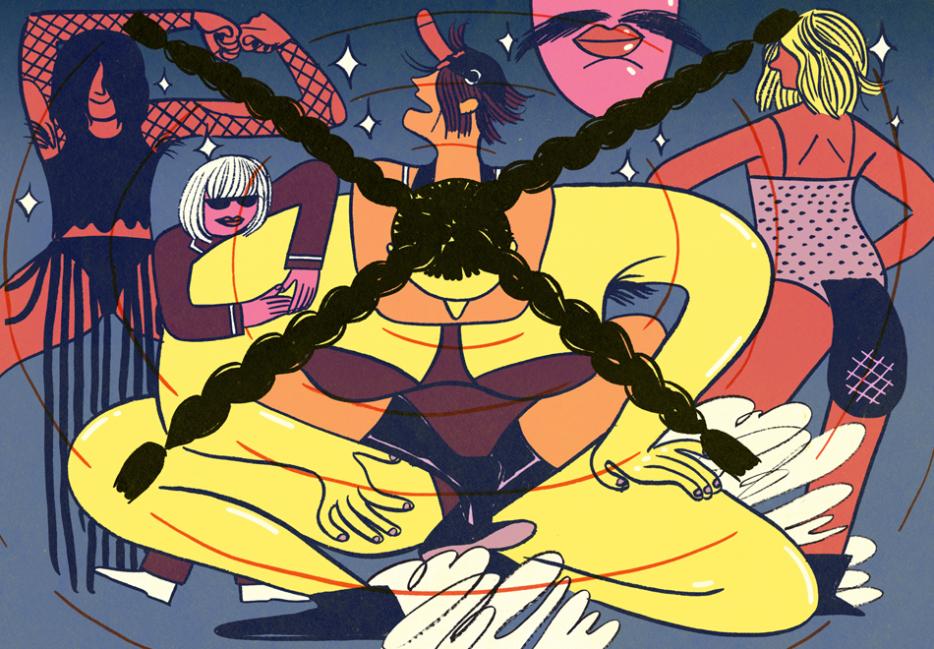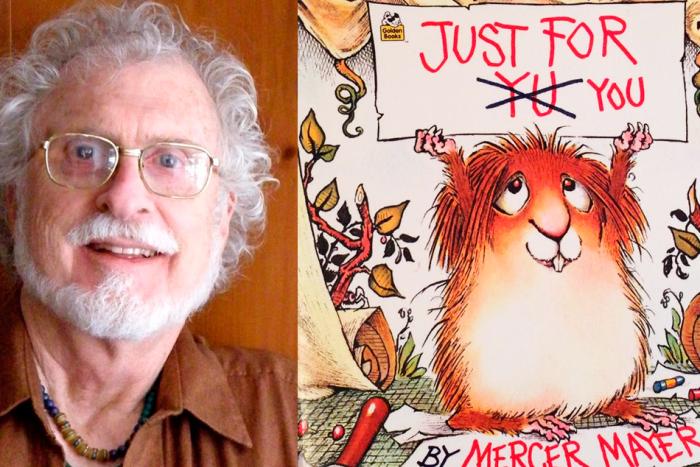This is not your typical retirement party. There are three hundred of us gathered at Gibraltar Point on Centre Island, a 20-minute ferry ride and 30-minute walk away from Toronto. The sun has set. Lights are strung over the treetops. Cans of beer are in hand. The scene would be romantic were we not all standing around a dirty, beat-up wrestling ring.
Tonight’s guest of honour is Big Jody Mufferaw. Her name is a tongue-in-cheek play on Ottawa folklore legend Big Joe (forever immortalized in a Stompin’ Tom Connors song), and Jody is a lumberjack with a penchant for battle. For the past three years, she has been the face of the League of Lady Wrestlers. Ironically enough, there’s nothing particularly “big” about league founder Aubyn O’Grady, who plays Jody. When the announcers introduce her, she crawls into the ring and her head barely peeps over the top rope. While she speaks, she swings a foam axe around; I hold my breath in fear that she might wind herself.
“I’ve chopped down many trees—and many women in the ring,” Jody boasts to the crowd. “But I can’t come to terms with the environmental and emotional destruction I’ve caused. That’s why I’m retiring.” There’s applause. But as she speaks, Jody’s nemesis, Beaver Fever, slowly emerges from the brush behind her and swipes her prized axe. “If you want your axe, you’ll have to come get it,” Beaver says as she races to the shore of Lake Ontario. Jody strips off her western-style, powder blue button-down, reveals a maroon onesie, and goes after Beaver Fever. The crowd follows the fight, trekking with glow sticks and cameras to the beach.
In the water, the pair performs their choreographed fight. From the shore, it looks like dressed-up synchronized swimming, twists and turns and lifts executed with precision. Bodies are slammed, heads dunked. The pair scuffle inside Beaver’s homemade “dam,” only momentarily popping out for air. Then Jody retrieves her axe, bops Beaver on the head with its handle and emerges victorious—returning to the beach only to grab a torch and set Beaver’s dam ablaze.
The September performance marks the peak of the league’s second-annual all-female Island Rumble. What began in Dawson City, Yukon, as a one-off art production has now spread to three cities across the country, giving female-identifying wrestlers the chance to train and hop in the ring in front of hundreds of spectators.
At the core of these performances—beyond the acrobatics, the scripted trash talk, and the finishing moves—are wrestlers’ alter egos, the characters and the backstories that bring the fights to life. At this match, Jody’s retirement mirrors O’Grady’s own step away from the ring after years of wrestling. “Big Jody is such a big part of me now,” she says. “But playing her takes a lot out of me. I think it’s time to say goodbye.”
While O’Grady may be retiring, dozens of other women are joining the league to dream up their own characters. When professional lives stifle creativity, the league offers a chance to be, as the wrestlers say, “your fantasy self.” Even more so, it is an opportunity to embrace strength and femininity through the reclamation of one of the world’s least female-empowered sports. Battling it out at this bizarre, secluded event is, as one wrestler puts it, “like letting your freak flag fly.”
*
It began with rejection. In 2012, O’Grady was living in Dawson City, eager to start her next art project. Through brainstorming with her former roommate, an avid wrestling fan, and a friend, she dreamt up the concept of the League of Lady Wrestlers. “We thought it’d be cool to get a wrestling ring and put it on the Yukon River while it was frozen and host a wrestling match,” she says. That idea was shot down quickly when O’Grady—to little surprise—could not secure arts funding; what would have been known as the River Rumble was far too “out there,” she speculates, to be eligible for government grants.
Women first stepped into the ring in the early 20th century to fill Depression-era sports arenas whose revenue streams were slowly dying. They were advertised as freak shows.
Still, the idea stuck, and a year later, O’Grady took it upon herself to make the wrestling happen. She set out to build the ring herself: one day, while cruising through YouTube, she found a video ("set to calming guitar music," she emphasizes) that showed how to construct one with old tires. The plan was put in motion. She and her friends collected a few dozen tires from the junkyard. Old planks of wood were also scavenged, poured into buckets of cement for stability. A dirty white tarp would suffice as the floor of the ring. It looked less than glamorous—though silver streamers were taped up atop the corners of the ring—but it was nonetheless a suitable place to wrestle.
O'Grady was living at Hobo Mansion, an old cabin built on a grassy plateau in Dawson, at the time. Outside the cabin was wide-open space, where the first event, "The Hobo Showdown," would be held. Rather than choreograph the matches, she and her friends winged their performances. During one match, O’Grady rolled out of the ring and landed on a shattered beer bottle; she needed nineteen stitches. But the show was a success: more than 100 spectators showed up to cheer the women on. The League of Lady Wrestlers was born.
Today, some of the original members continue to plan shows in Dawson City, while O’Grady runs the Toronto chapter. Others have started one in Montreal. In total, the league boasts around forty members, In Toronto, attendance has steadily grown from about 100 to 300 and those without tickets beg for them on Facebook event pages. Every Toronto show has sold out, and the larger audiences expect more than improvised productions. Prior to the first match in the city (the “Hogtown Throwdown”), a professional wrestler trained the women participating, and O’Grady rented a real ring. The wrestlers began choreographing their matches; every show is scripted. In preparation of Island Rumble II, the sixteen women wrestling held three-hour practices months in advance of the event. On their own time, they also perfected their characters’ elaborate back stories and costumes. Though O’Grady says most women recruited have an idea of who they want to play, forming their stories involves a great deal of contemplation. But everyone has an inner wrestler: “One of the things that kept the league going was realizing the characters were extensions of ourselves, someone who you think maybe you are, or a weird part of your personality you get to put on display,” she says.
Erin Fleck plays Kitty Stardust, a former vet technician-cum-cat lady who became the front woman of glam-rock T. Rex cover band Pterodactyl. Fleck, a playwright, says Kitty combines all of her favourite pastimes—so much so that she designed band tees to wear in the ring. “It’s my dream self,” she tells me. The persona of her opponent at the Island Rumble II is equally intricate: Lauryn Kronick’s Sqrue Younicorn is adorned in a rainbow unicorn-themed unitard, with glitter painted like a mask over her eyes. The piece de resistance: a strap-on harness and bright pink dildo worn atop her head like a horn—both Kronick and Fleck have decided it is the centrepiece of Younicorn’s powers.
In many ways, mainstream wrestling performances borrow from queer aesthetic and identity.
Kronick and Fleck, like all of the League of Lady Wrestler participants, are volunteers. Everyone has a day job, or spends their days studying. Even O'Grady, who has devoted hours to organizing the league, works a 40-hour week at the University of Toronto Physics Department in administration. Wrestling is strictly extracurricular.
But it is precisely the non-professional nature of the league that draws its performers in. For those who don't identify as artists in their work lives, wrestling as an alter ego provides a creative outlet. Kronick is a prime example, working in communications at the Canadian HIV/AIDS Legal Network. After hours deep in policy, Sqrue Younicorn is an escape—a queer-inspired mythical character who celebrates the best of identity in performance. These characters are completely removed from reality, but they are distinctive enough to separate professional life from fictional art. It is these performances that the wrestlers can be their zaniest selves: a positive transformation.
At a dress rehearsal the weekend before the Island Rumble, Kitty and Sqrue practice their match: showboating to The Rolling Stones’ “(I Can’t Get No) Satisfaction,” followed by faux hair pulling and a finishing move called the “rainbow evisceration,” which leaves Younicorn’s innards (a pile of colourful streamers) strewn on the practice mat. But when 4:30 p.m. rolls around, Kronick returns to reality and heads home for a Rosh Hashanah meal with her family.
“Don’t worry,” she says before leaving, dildo in hand. “I’m going to change my outfit before dinner.”
*
The ferry to Centre Island the day of the match is packed with bicycles and concealed paper bags full of liquor. Curious, an older man asks a media photographer what all the hubbub is about. “We’re going to see women wrestle. It’s an all-female wrestling league,” she answers enthusiastically. Perplexed, he raises an eyebrow. “Well, that seems pretty weird.” But the spirit of the League of Lady Wrestlers is not far removed from mainstream wrestling. Worldwide Wrestling Entertainment, which reeled in more than $30 million last year, is known for its outlandish narratives and over-the-top personas—not unlike the women at the Island Rumble. For every Sqrue Younicorn with a dildo atop her head, there’s an Undertaker in a speedo tossing his curly black locks at opponents.
In many ways, these mainstream performances borrow from queer aesthetic and identity. Male performers hop into the ring in tight leather outfits—the kind you’d see on a Saturday night at the local leather bar. But when matched with the hyper-masculine act of violence, these performances are viewed not as homoerotic, but as feats of strength. As Sharon Mazer explores in her book, Professional Wrestling: Sport and Spectacle, wrestling is transgressive in its merging of macho and camp; it is acceptable to “dance around” and “tease” men in the ring so long as the performance comes hand-in-hand with the “brute,” the beatdowns. For the League of Lady Wrestlers, performances undo this transgression to bring this aesthetic to the forefront.
In mainstream North American wrestling culture, however, portraying women in the ring as “strong” is uncommon. The WWE refers to its female participants—not just wrestlers, but ring announcers and managers, too—as “divas,” promoting them as “smart and sexy.” These fighters are typically clad in cute but impractical outfits and are marketed to please male viewers. This has never been more evident than when the WWE angled for more male viewership by debuting HLA—Hot Lesbian Action—in 2002, a storyline during which two women stripped down to their underwear and were scripted to fondle each other in the ring. Promoter Eric Bischoff later instructed the pair to “go at it” in front of a largely male audience. (I reached out to the WWE in hopes of speaking to some professional female wrestlers, but the league insisted they could not accommodate my request.)
In these spaces free from judgement—and even more so, the male gaze—these women open themselves up to a new identity: the kind of person they could be without restraint, fear, or limitations.
According to Patrice Oppliger’s Wrestling and Hypermasculinity, women first stepped into the ring in the early 20th century to fill Depression-era sports arenas whose revenue streams were slowly dying. They were advertised as freak shows: women who should have been passive and docile would beat down powerful men in a reversal of roles. “Women were seen then as unpredictable and emotionally unstable,” Oppliger writes. The first woman-versus-woman match came a decade later, in the 1930s, but these were quickly banned across the U.S. for fear that women might “immorally seduce male audiences.” From then on, women partook in the sport as cheerleaders, or “ring dressings.” As an extension of this role, they began wrestling again in the 1990s—this time, hyper-sexualized, for the exact purpose they were banned for in the first place: to please the men watching.
In many ways, the League of Lady Wrestlers has returned to that original ’20s concept of strong, powerful female fighters. “The professional wrestling ring is traditionally a male-dominated space,” the league’s official pamphlet reads. “Our events are more than just simple battles between faces and heels.” Instead, they offer a reclamation of the sport, an undoing of the hypermasculinity the ring has fostered for nearly a century. The wrestlers poke fun at this whenever they can: Black Widow performs the “female gaze” to paralyze her opponent. Helga Hysteria breaks free from the chains of her alcoholic partner and rips off her dress to gain power. Lilac Poussez resists The Guardian’s sexual advances, insistent that she wants to fight, not “Netflix and chill.” Many identities—the likes of The Stinker and Garbageface, for instance—are intentionally disgusting, meant to repulse and not attract viewers. Others mock the traditional sexualization of women in the ring by playing it up perversely, flirting with opponents until they have reached peak discomfort. “Initially, the whole idea of the league was to bring an audience who expect a sexy show when they hear of women wrestling and to change their minds about female performance and performing strength,” O’Grady says. As I reach Gibraltar Point for the Island Rumble, I see the older man from the ferry pacing by the entrance, hoping to catch a glance of the sold-out show.
*
While fighting under fairy lights on an island away from the city may seem exciting, if not glamorous, the road to get there is decidedly much less attractive. A few days before the Island Rumble, I head to the west end of Toronto, near some industrial buildings, to the League of Lady Wrestler practice space. The team rents this giant, white-washed room full of mats to rehearse; today, they’ll be here for six hours. To me, the room is cold and damp, but to the women picking each other up and slamming one another on the ground, it feels like a boiler room.
The purpose of rehearsals is to memorize scripts and become comfortable with wrestling partners—and, if possible, prevent any unwanted injuries. One by one, the wrestlers read through their scripts and act out their matches sans props and in a far less believable manner. Costumes are an afterthought. Bodies move more slowly. Wrestlers test each other’s limits. In this environment, the women look more like teenagers in gym class than performers.
But in this space, the women of the league are cultivating their identities. I am taken aback when, upon arrival, O’Grady introduces me to the others not by first name, but by their alter egos. “That’s Sqrue (pronounced Screw) and Kitty,” she tells me, pointing to the pair on the mat. “I think Garbageface will be here soon, too.” The rest of the women do the same, only periodically calling out for Aubyn—not Jody—to cue up their introductory music.
For the wrestlers, keeping in character is key. O’Grady emphasizes that the shows are strictly art performances, critiques on the macho world of wrestling. To achieve that, elaborate characters and narratives are needed to compel the viewers. These personas are, for the most part, extensions of the wrestlers themselves. In these roles, women are free to explore their strength and physicality in ways their everyday identities might restrict. Here in the practice space, they moan and groan loudly, contort their bodies, and roll around the mats freely. In these spaces free from judgement—and even more so, the male gaze—these women open themselves up to a new identity: the kind of person they could be without restraint, fear, or limitations.
*
In the final act of the Island Rumble, each star wrestler hops into the ring for one last smackdown. For O’Grady, it will be her last opportunity to fight as Big Jody. “My stomach is all excitement and nerves,” she tells me before the show begins. Neither are evident in her expression as she watches on from the sidelines, awaiting her cue: she is collected, scanning the ring to make sure nothing has malfunctioned and no one is hurt. Then she’s up, and she rushes in, transforming from O’Grady to Mufferaw on call.
The scene is overwhelming. With a dozen people in the ring, limbs are flailing everywhere, and it’s hard to deduce who is winning or losing. Things only become clear once Jody is in the centre, facing reigning Island Rumble champ Sweetie. Sweetie gives Jody a swift beating. At one point, a dazed Jody is dragged in a waltz with the wrestler, her hair still matted from her dip in the lake earlier on. Then it happens: the referee counts to three, and Jody is lying stunned in the ring. Defeat. Big Jody Mufferaw is officially retired.
Later, I see O’Grady surrounded by friends, a beer in hand: no trace of Jody. Living in Toronto full-time, O’Grady has perhaps outgrown her lumberjack alter ego. These days, she says, she’ll focus on management.
But it may not be the end of her in the ring. Before the final fight, I remind O’Grady it’s her last time duking it out with the wrestlers. “As Big Jody,” she clarifies. “Just for now. Maybe I’ll create someone new.” A new character, to better represent the woman she is today.






